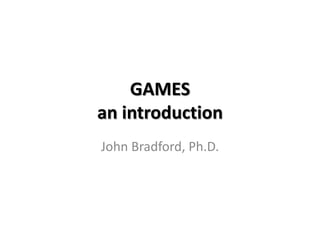
Lecture 2 so 211 games
- 1. GAMES an introduction John Bradford, Ph.D.
- 2. What are ‘Games?’ • In “game theory,” a ‘GAME’ is an interaction of decision-makers. – The Key idea is that players make decisions that affect one another. • Ingredients of a game: 1. The players 2. Their options (i.e. possible ‘moves’) 3. Possible outcomes 4. ‘Payoffs’- (i.e. players preferences among those outcomes)
- 3. What are ‘Games?’ • A ‘Game’ in this sense includes games like chess, tic-tac-toe, football, basketball, etc. • A ‘game’ as defined also includes any real-life situation in which our decisions influence one another. – (Remember the definition of sociology?)
- 4. Describing Games • Remember, a game is simply a situation of interactive decisions. We can describe these interactive situations: 1. Verbally 2. Using a matrix (= table) 3. Using a Tree diagram
- 5. Matrix Descriptions Rock, Paper, Scissors STEP 1: Write down the options for both players in a table. – Player 1 = row chooser – Player 2 = column chooser ROCK PAPER SCISSORS ROCK PAPER SCISSORS
- 6. Matrix Descriptions Rock, Paper, Scissors STEP 2: Write down the ‘payoffs’ (i.e. preferences) for each possible joint outcome. – Below I use numbers, +1 to indicate a win, -1, to indicate a loss, and 0 to indicate a draw. – Note that there are two different payoffs! ROCK PAPER SCISSORS ROCK 0,0 -1, +1 +1, -1 PAPER +1, -1 0, 0 -1, +1 SCISSORS -1, +1 +1, -1 0,0 PLAYER 1 PLAYER 2
- 7. Matrix Descriptions Rock, Paper, Scissors • By convention, the first number is the payoff to Player 1 (the row chooser). The second number is the payoff to Player 2 (the column chooser). – If you only see one number, it is always from the point of view of Player 1. ROCK PAPER SCISSORS ROCK 0,0 -1, +1 +1, -1 PAPER +1, -1 0, 0 -1, +1 SCISSORS -1, +1 +1, -1 0,0 PLAYER 1 PLAYER 2
- 8. Matrix Descriptions • Notice that: 1. Players make their moves simultaneously ( they do not take turns), and also that, 2. R…P…S… is depicted as a ZERO-SUM GAME. – “Zero-sum” refers to a situation in which the gains of one player are exactly offset by the losses of another player. If the total gains of the participants are added up, and the total losses are subtracted, they will sum to zero. • TOTAL GAINS = TOTAL LOSSES
- 9. Zero-sum • In a zero-sum game, one person’s gain comes at the expense of another person’s loss. • Example: Imagine a pizza of fixed quantity. If you eat one more slice than I do, I necessarily eat one slice less! More for you = Less for me. • Example: A thief becomes richer by stealing from others, but the total amount of wealth remains the same.
- 10. Zero-sum • Rule: a game is zero-sum if payoffs sum to ZERO under all circumstances. – For example, Player 1 chooses Rock and Player 2 chooses Scissors. The aggregate payoff is: 1 – 1 = 0. ROCK PAPER SCISSORS ROCK 0,0 -1, +1 +1, -1 PAPER +1, -1 0, 0 -1, +1 SCISSORS -1, +1 +1, -1 0,0
- 11. Zero-sum • Example: ‘Matching Pennies’ – Rules: In this two-person game, each player takes a penny and places it either heads-up or tails-up and covers it so the other player cannot see it. Both players’ pennies are then uncovered simultaneously. Player 1 is called Matchmaker and gets both pennies if they show the same face (heads or tails). Player 2 is called Variety-seeker and gets both pennies if they show opposite faces (one heads, the other tails). HEADS TAILS HEADS +1, -1 -1, +1 TAILS -1, +1 +1, -1 Matchmaker Variety-Seeker
- 12. Constant-sum and Variable-sum • Not all games are zero-sum games! 1. A situation in which the total payoffs are fixed and never change, but do not necessarily equal zero, is called a constant-sum game. – Note: Zero-sum games are a kind of constant-sum game in which the constant-sum is zero. 2. Variable-sum games are those in which the sum of all payoffs changes depending on the choices of the players! The game prisoner’s dilemma is a classic example of this! (You will have to show this yourself)
- 13. Tree Diagrams • Tree diagrams (aka ‘decision-trees’) are useful depictions of situations involving sequential turn-taking rather than simultaneous moves. • Asking Boss for a Raise? Employee 0,0 Boss 2, -2 -1, 0
- 15. Dominant Strategy • In Game Theory, a player’s dominant strategy is the choice that always leads to a higher payoff, regardless of what the other player(s) choose. – Not all games have a dominant strategy, and games may exist in which one player has a dominant strategy but not the other. – In the game prisoner’s dilemma, both players have a dominant strategy. Can you determine which choice dominates the others?
